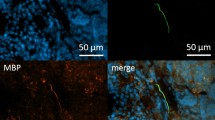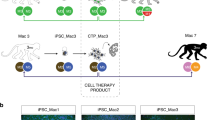Abstract
Grafting of neural tissue has been used to investigate the ability of central nervous system (CNS) axons to elongate into peripheral nerve grafts1,2; to investigate the growth characteristics of material transplanted within the CNS3,4; and to determine if grafts producing amines or peptides can replace a natural5,6 or experimentally induced depletion7,8 of these biogenic molecules. In such experiments donor tissue has been distinguished from host by injection into graft cells of horseradish peroxidase1,2 or radioactive leucine9 or by detecting biogenic molecules in the grafted tissue with antibodies6–8. All these methods have limitations and a technique which allows identification of the total neuronal cell output from transplanted tissue would be a powerful tool in delineating host–graft interactions. Polymorphic cell-surface antigens have not previously been exploited as markers. The Thy-1 antigen is an abundant glycoprotein of neurones and in the mouse exists in two allotypic forms called Thy-1.1 and Thy-1.2. We now show that tissue from Thy-1.1-positive animals grafted into Thy-1.1-negative brains can be clearly identified in cryostat sections using an anti-Thy-1.1 monoclonal antibody conjugated with peroxidase. We have used the method to study grafts from normal fetal mice which correct a developmental deficiency when transplanted into hpg mutant mice.
This is a preview of subscription content, access via your institution
Access options
Subscribe to this journal
Receive 51 print issues and online access
$199.00 per year
only $3.90 per issue
Buy this article
- Purchase on Springer Link
- Instant access to full article PDF
Prices may be subject to local taxes which are calculated during checkout
Similar content being viewed by others
References
David, S. & Aguayo, A. J. Science 214, 931–933 (1981).
Benfey, M. & Aguayo, A. J. Nature 296, 150–152 (1982).
Das, G. D., Hallas, B. H. & Das, K. G. Am. J. Anat. 158, 135–145 (1980).
McLoon, L. K., Lund, R. D. & McLoon, S. C. J. comp. Neurol. 205, 179–189 (1982).
Gash, D., Sladek, J. R. Jr & Sladek, C. D. Science 210, 1367–1369 (1981).
Krieger, D. T. et al. Nature 298, 468–471 (1982).
Björklund, A., Stenevi, U. & Svendgaard, N. A. Nature 262, 787–790 (1976).
Low, W. C. et al. Nature 300, 260–262 (1982).
Jaeger, C. B. & Lund, R. D. Brain Res. 165, 338–342 (1979).
Reif, A. E. & Allen, J. M. Nature 209, 523 (1966).
Williams, A. F., Barclay, A. N., Letarte-Muirhead, M. & Morris, R. J. Cold Spring Harb. Symp. quant. Biol. 41, 51–61 (1976).
Barclay, A. N. & Hydén, H. J. Neurochem. 31, 1375–1391 (1978).
Morris, R. J. & Raisman, G. J. Neurochem. 40, 637–644 (1983).
Beech, J. A., Morris, R. J. & Raisman, G. J. Neurochem. 41, 411–417 (1983).
Beale, R. & Osborne, N. N. Neurochem. Int. 4, 587–595 (1982).
Williams, A. F. & Gagnon, J. Science 216, 696–703 (1982).
Mason, D. W. & Williams, A. F. Biochem. J. 187, 1–20 (1980).
Ledbetter, J. A. & Herzenberg, L. A. Immun. Rev. 47, 63–90 (1979).
Cattanach, B. M., Iddon, C. A., Charlton, H. M., Chiappa, S. A. & Fink, G. Nature 269, 338–340 (1977).
Greene, H. S. N. Cancer Res. 11, 529–534 (1951).
Barker, C. F. & Billingham, R. E. Adv. Immun. 25, 1–54 (1977).
John, M., Carswell, E., Boyse, E. A. & Alexander, G. Nature new Biol. 238, 57–58 (1972).
Björklund, A., Stenevi, U., Dunnett, S. B. & Gage, F. H. Nature 298, 652–654 (1982).
Hsiung, L-M, Barclay, A. N., Brandon, M. R., Sim, E. & Porter, R. R. Biochem. J. 203, 293–298 (1982).
Barclay, A. N. Immunology 42, 593–600 (1981).
Author information
Authors and Affiliations
Rights and permissions
About this article
Cite this article
Charlton, H., Barclay, A. & Williams, A. Detection of neuronal tissue from brain grafts with anti-Thy-1.1 antibody. Nature 305, 825–827 (1983). https://doi.org/10.1038/305825a0
Received:
Accepted:
Issue Date:
DOI: https://doi.org/10.1038/305825a0
This article is cited by
-
Cultivation of Purified Primary Purkinje Cells from Rat Cerebella
Cellular and Molecular Neurobiology (2018)
-
Histological signs of immune reactions against allogeneic solid fetal neural grafts in the mouse cerebellum depend on the MHC locus
Experimental Brain Research (1988)
-
Is Thy-1 expressed only by ganglion cells and their axons in the retina and optic nerve?
Journal of Neurocytology (1984)
Comments
By submitting a comment you agree to abide by our Terms and Community Guidelines. If you find something abusive or that does not comply with our terms or guidelines please flag it as inappropriate.



